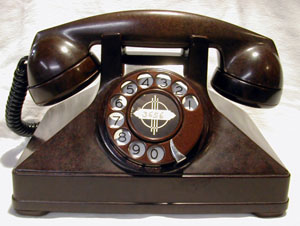
|
Northern Electric Uniphone -
No. 1
Desk Set
"Burled Walnut"
F1 handset
AE dial with brown fingerwhee |
|
|
Northern Electric Uniphone -
No. 2
Wall Set
"Burled Walnut"
NU handset
BPO dial
|
Uniphones
were
Northern Electric's combined set that included the
traditional desk set and subset components in one
package. In
general,
they use the same internal components as the Western and
Northern 302.
Uniphones were sold primarily to independent phone
companies, while the
302 was used within the Bell System in Canada.
Therefore, they
are
found with a variety of handsets, ringers and dials that
were added
based on local need and supply.
The NE T-7 catalog mentions two primary models, the No. 1
desk set and
No.2 wall set.
Deskset replacement models were also made with the same
housings and
only
a switchhook to
replace earlier sets such as candlesticks, and B and D
mountings.
Desk: No. 5 (manual) and No. 7 (dial)
Wall: No.6 (manual) and No.8 (dial)
Uniphones are usually found with the
NE #5
dials, but the catalog also
shows wiring for the AE #24 and BPO (British Post Office)
dials.
BPO
dials were often made by Siemens and have their name on
the
fingerstop. These dials were supplied for
comptibility with
switches
used by independents. Announcement documents and the
T-6 catalog
also show early Uniphones
supplied
with
the now scarce Northern N14 dial.
All were available in black or "burled walnut" (brown with
black
highlights).
A few desk sets in ivory have been found (see
below). They were
apparently never
marketed due to warping and color stability issues.
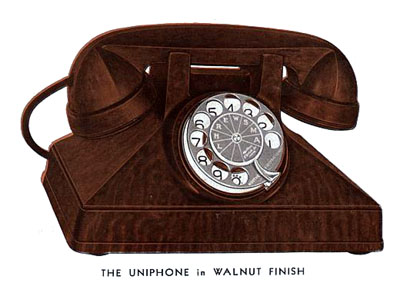 (From Uniphone
Announcement brochure.)
(From Uniphone
Announcement brochure.)
|
|
No.
1 / No.
2
No.
1 - Inside
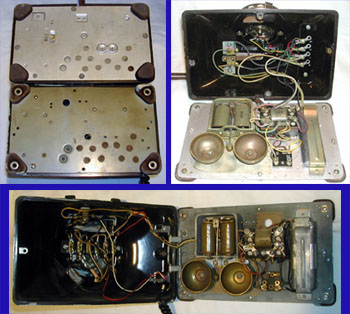
No.
2 - Inside
|
Left: No. 1 and No. 2
bottom
view. Note holes through feet for wall mounting of
No. 2.
Right: Inside view of No.1, showing B1A ringer, 101A coil
and
capacitor. Dated 1951.
Below: Inside view of No. 2, showing B1A
ringer, 101A coil
and capacitor. Dated 1940.
Note the hinge mechanism in the center that firmly holds
the housing to
the bottom plate. Very useful for maintenance after
wall mounting.
|
NF
NU
F1
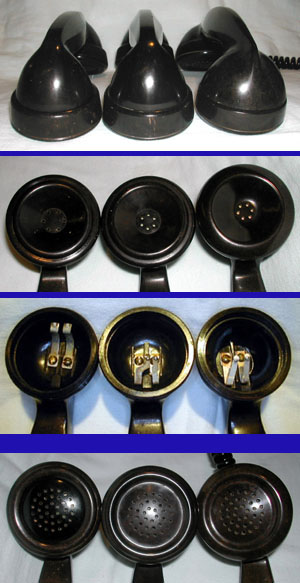
NF
NU
F1
|
Uniphone
handset
evolution
Shown left to right:
NF NU F1
NF and NU have a taller, more angular handle than
the F1,
with a flat
ridge down the back. At first glance, they appear
identical, but
have subtle differences.
The receiver caps on all three are different, but have the
same threads
so can be
interchanged. NU and NF have a similar
cross-section, but the
circular hole pattern is tighter on the NU. The F1
cross section
is smoother and not as tall.
Contact springs are different, depending on the receiver
capsule used
(see 2 styles shown below).
The cavity casting is the same for the NF and NU, but
different style
springs are used for the two capsules. Although both
NF and NU
will take either spring set, so either capsule may be
used, I have
never seen a NU handset with the earlier capsule.
The cavity and springs for the F1 were apparently
simplified for
manufacturing economy.
The NF uses a 2-piece transmitter cap. The black
plate with hole
pattern is an insert, similar to the one used on the E
handset
transmitter.
All models use the same F-style transmitter elements that
were used in
both Northern and Western late E and most F-model
handsets.
|
D 96337
HA1
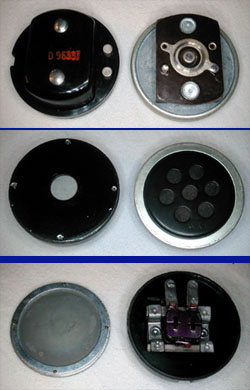
D 96337 with
diaphragm
removed
|
Receiver Capsules
Early NF handsets used a D 96337 capsule (left).
Later NFs and all NUs and most F handsets used the
HA1-style capsule
(right).
The D part number suggests it was a design model and not
intended for
volume manufacturing. The diaphragm is held on by
magnetic
attraction only.
The HA1 is a sealed unit. The circular contact
symmetry means the
capsule does not have to be properly physically aligned
when installed.
The lower photo shows the D 96337 with diaphragm removed.
|
|
Photos from
Glenn
Pitre
|
No. 1 Uniphone with NU
handset and BPO dial in ivory, showing the common color
stability
issues and some warping.
|
